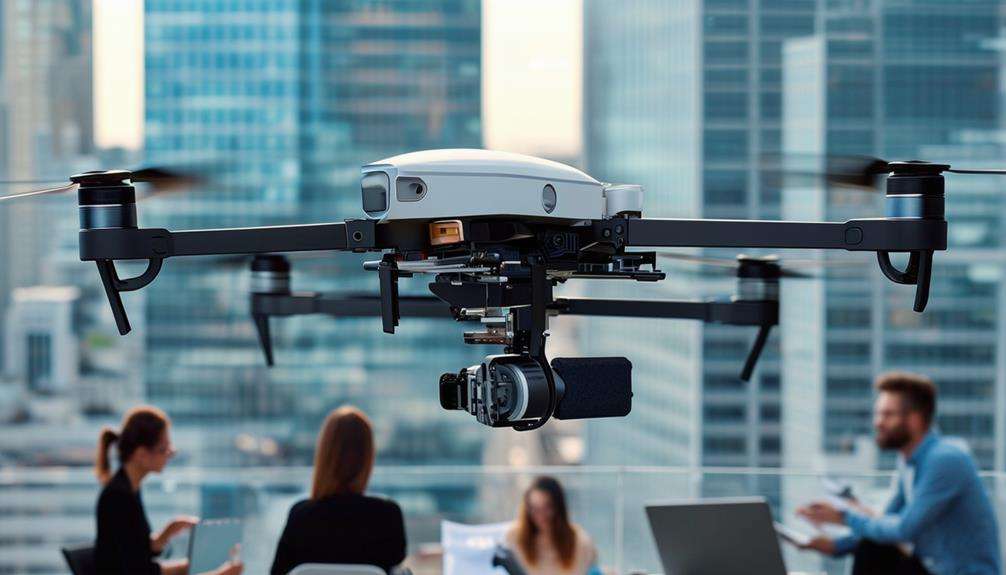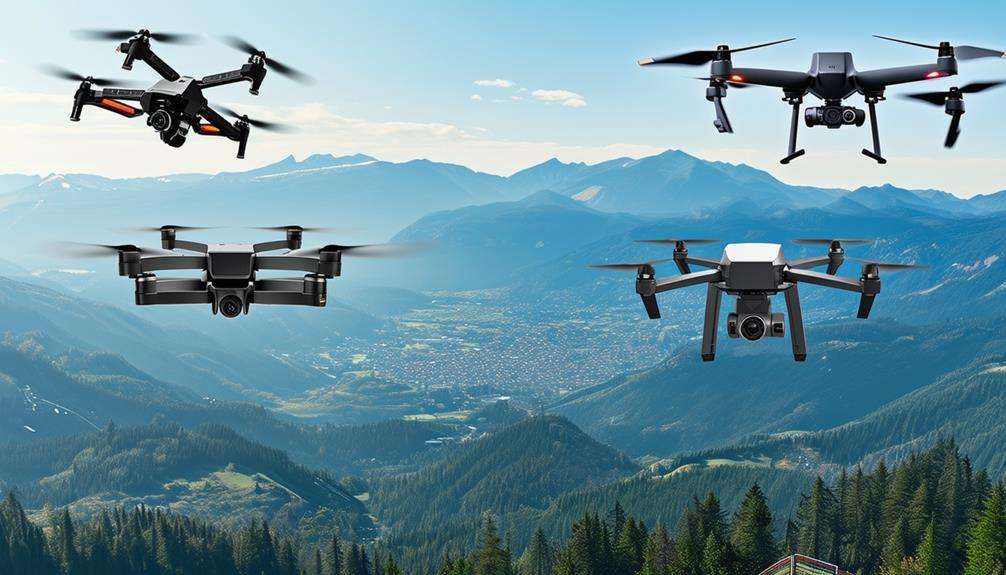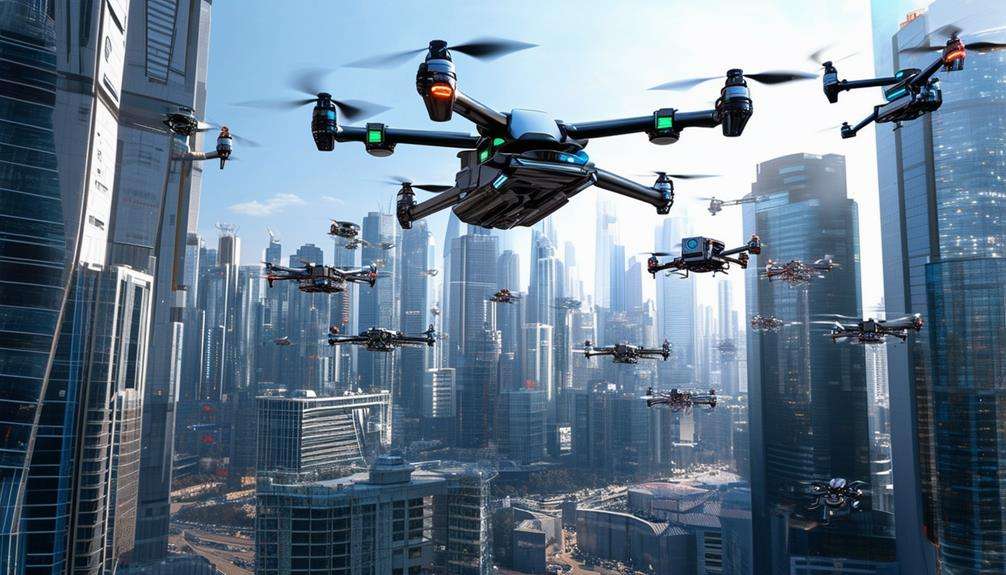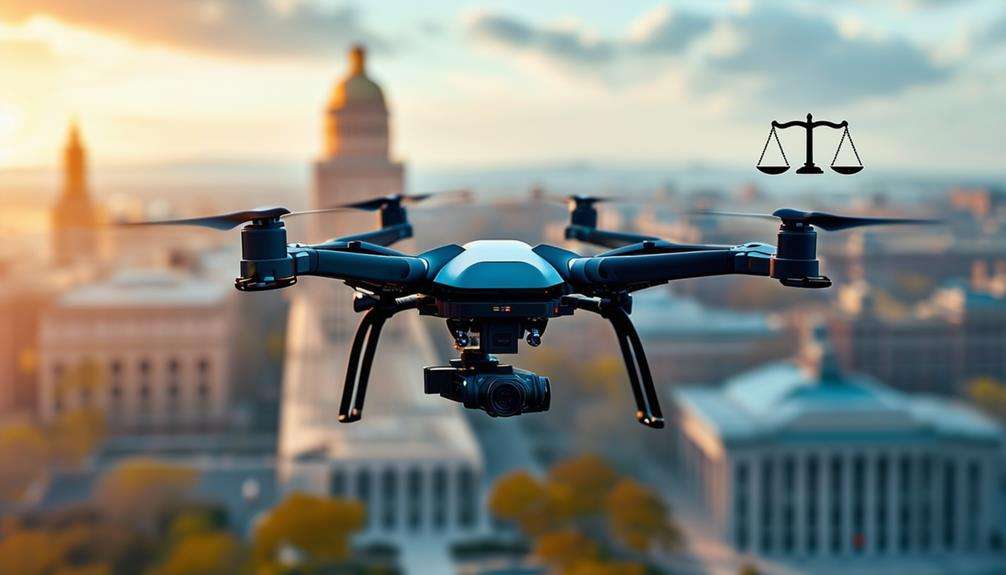Commercial Drones: Trends to Watch in 2024
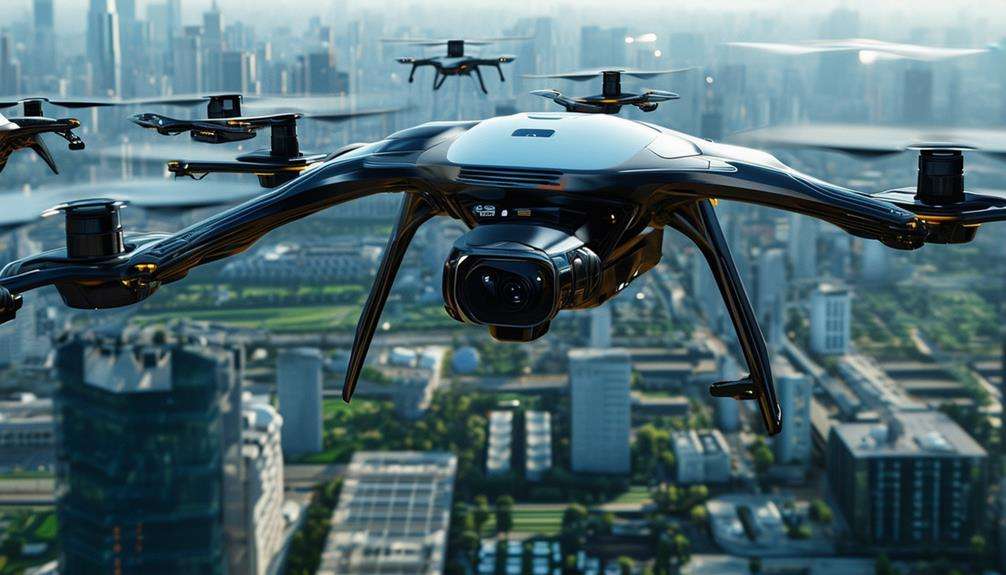
As you explore the commercial drone industry for 2024, you'll encounter several key trends poised to transform the landscape. The integration of AI for enhanced autonomy and anticipated regulatory changes that could permit Beyond Visual Line of Sight (BVLOS) operations are among the most significant. Urban air mobility is emerging as a pivotal element for sustainable transportation, while specialized services are being developed to address unique industry needs. What do these advancements mean for businesses and consumers? Let's delve into how these developments could impact you and the broader market.
Increasing Commercial Adoption
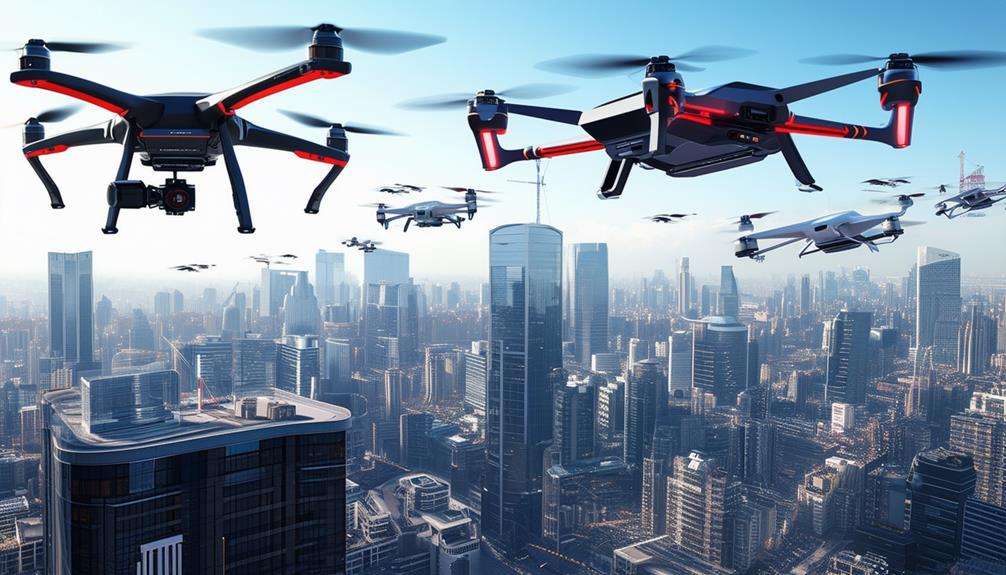
In 2024, companies worldwide are increasingly adopting drones to enhance efficiency and reduce costs. Drone industry trends are shifting rapidly, driven by technological advancements and their diverse applications across various sectors. Businesses are integrating drones for inspections, surveys, deliveries, and monitoring, making them indispensable tools in their operations.
The technology behind drones is evolving quickly, offering more robust, reliable, and versatile solutions. For example, in construction, drones are used for site inspections and progress monitoring, greatly reducing time and labor costs. Agriculture is another key industry where drones are making a significant impact. Farmers use them for crop monitoring, pesticide spraying, and soil health evaluation, leading to enhanced productivity and resource management.
Additionally, logistics companies are leveraging drones for last-mile deliveries, speeding up the process and reducing transportation costs. Energy companies use drones to inspect pipelines and power lines, improving safety and efficiency. The increasing commercial adoption of drones is a clear indicator of how industries are embracing cutting-edge technology to stay competitive and forward-thinking in 2024.
Regulatory Changes
Alongside the surge in commercial drone adoption, regulatory changes are paving the way for more extensive and creative drone operations. The FAA has been proactive, granting more Beyond Visual Line of Sight (BVLOS) waivers, which is a game-changer for the commercial drone industry. These waivers allow for long-distance flights essential for retail deliveries and infrastructure inspections, making operations more efficient and scalable.
In 2024, several key regulatory changes are expected:
Increased BVLOS Waivers: The number of companies receiving BVLOS waivers is projected to rise, broadening the scope of commercial drone activities.
Final BVLOS Regulations: The FAA is anticipated to finalize rules on BVLOS flights, enhancing both flight performance and safety.
Expansion for B2B Deliveries: Expanded BVLOS authority for B2B cargo drone deliveries will focus on larger and heavier drones, optimizing supply chain logistics.
These regulatory changes will enable drone companies to operate at scale across multiple suppliers, reducing operating costs and improving efficiency. As these regulations evolve, more opportunities will arise for innovation and expansion in commercial drone operations.
Advancements in Drone Technology
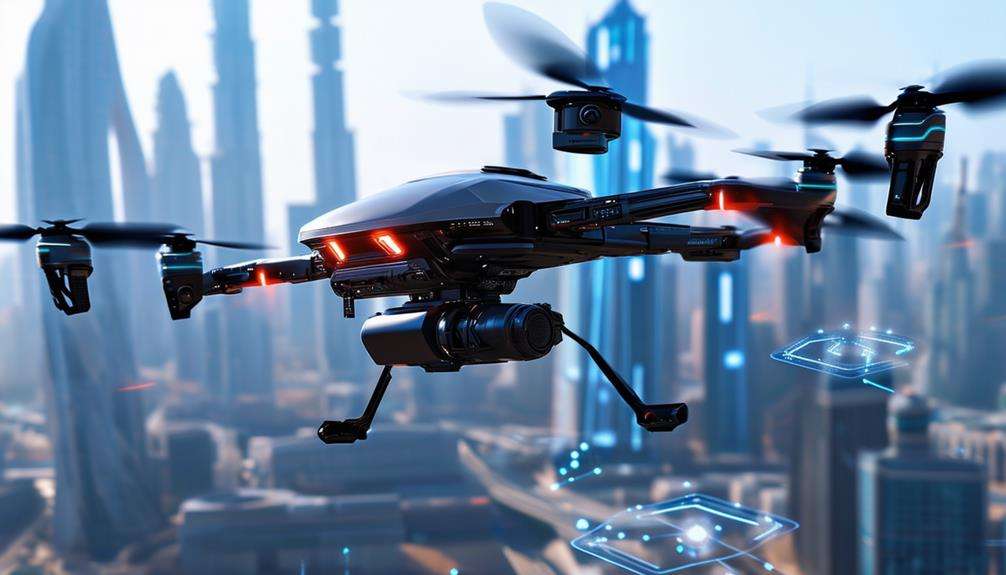
The integration of AI in autonomous flight systems is transforming drone technology, enabling more sophisticated decision-making and precise obstacle navigation. This leap forward allows drones to effortlessly navigate challenging environments, autonomously avoid obstacles, and significantly reduce collision risks, ensuring safer operations.
AI-driven data analytics further enhance decision-making by extracting actionable insights from the vast data drones collect. These insights are crucial for optimizing operations across various sectors, including industrial inspections, environmental monitoring, and precision agriculture. For example, in agriculture, AI-enabled drones assist farmers in managing crops more effectively, improving yields and resource utilization.
Predictive maintenance is another critical area benefiting from AI integration. AI algorithms analyze data from drone systems to predict potential failures, enabling preemptive maintenance and preventing costly breakdowns. This not only prolongs the lifespan of drones but also ensures they operate at peak efficiency.
Urban Air Mobility
Urban Air Mobility (UAM) promises to revolutionize urban transportation, offering a faster and more efficient alternative to traditional ground transit. Imagine bypassing congested streets by soaring through the skies in an air taxi. Companies like Uber, Airbus, and Volocopter are already developing UAM solutions that could soon become part of your daily commute.
UAM aims to alleviate urban congestion, enhance transportation efficiency, and provide sustainable travel options. Picture a network of vertiports scattered throughout your city, allowing drones and air taxis to take off and land seamlessly. These vertiports will serve as the hubs that make UAM a practical reality, connecting different parts of the city in ways previously unimaginable.
Key benefits include:
- Speed: Reach your destination in a fraction of the time.
- Convenience: Enjoy hassle-free travel with fewer delays.
- Sustainability: Reduce your carbon footprint with eco-friendly transportation.
Urban Air Mobility isn't just a futuristic concept—it's on the brink of transforming urban landscapes. By embracing UAM, the future of urban travel will be quicker, more efficient, and environmentally friendly.
Integration With AI
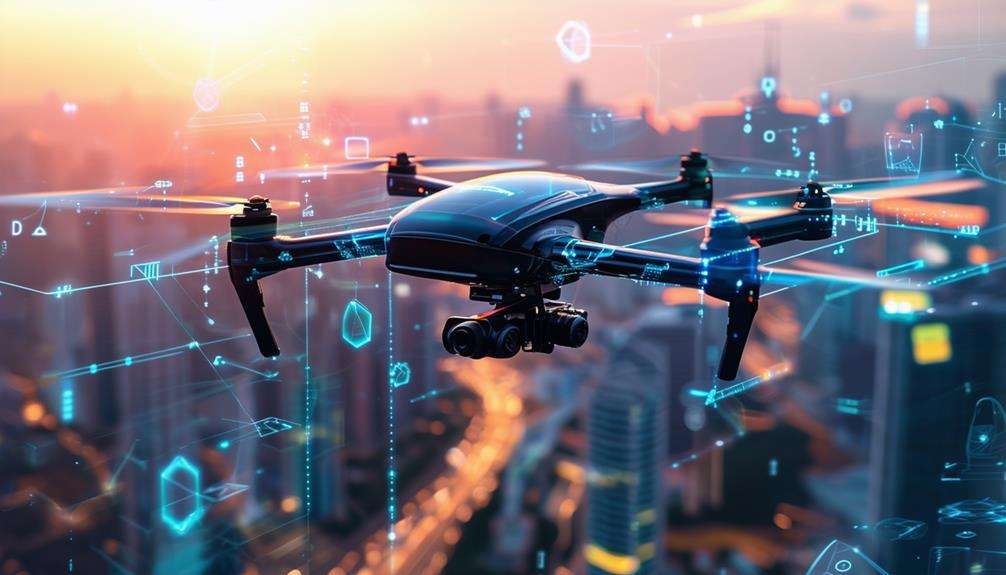
Integrating AI with commercial drones empowers advanced decision-making, enhancing operational efficiency and effectiveness. AI-driven predictive maintenance can foresee potential issues, minimizing downtime and costs. This advanced automation results in smarter, safer, and more reliable drone performance.
Enhanced Decision-Making Capabilities
Imagine drones that can't only fly autonomously but also make smarter decisions in real-time, thanks to advanced AI technologies. This integration significantly boosts the operational efficiency and safety of commercial drones.
With AI-driven data analytics, drones can provide real-time insights and predictive analytics, enabling quicker and more informed decision-making. Picture the possibilities when drones can instantly analyze data and adapt their flight paths based on environmental conditions.
AI-powered obstacle avoidance systems are a critical component, enabling drones to navigate complex terrains safely. These systems use sophisticated algorithms to detect and avoid potential hazards, reducing the risk of collisions and ensuring smoother operations. It's not just about flying; it's about flying smarter and safer.
Consider the emotional impact of these advancements:
- Peace of Mind: Knowing that drones can autonomously avoid obstacles and make real-time decisions.
- Increased Efficiency: Leveraging AI-driven data analytics for timely and accurate insights.
- Enhanced Safety: Relying on AI-powered obstacle avoidance systems to prevent accidents.
Incorporating AI into commercial drones isn't just an upgrade; it's a revolution in aerial operations.
Predictive Maintenance Solutions
AI-powered predictive maintenance solutions are revolutionizing the commercial drone industry by minimizing downtime and enhancing safety. Through detailed data analytics, these solutions enable drones to predict maintenance needs, addressing potential issues before they escalate, thus significantly reducing operational costs.
AI algorithms analyze performance data to anticipate component failures, facilitating proactive maintenance. This approach doesn't just save time; it also prevents accidents and expensive repairs by identifying issues early. Consequently, this enhances the overall safety and reliability of drone operations.
Incorporating AI-driven predictive maintenance solutions has become essential in the commercial drone sector. These technologies improve traditional maintenance practices, ensuring the longevity and optimal performance of drones used for delivery, surveillance, or industrial inspections. AI integration keeps your drones mission-ready and in peak condition.
Adopting AI in predictive maintenance isn't merely a trend but a necessity for maintaining competitiveness in the evolving commercial drone landscape. Leveraging these advanced solutions optimizes uptime, enhances safety, and ensures operational efficiency.
Expanded BVLOS Operations
With more FAA waivers for BVLOS flights, companies can expect regulatory challenges as they seek expanded operational capabilities. Technological advancements will be crucial for meeting safety standards and enhancing flight performance. Specific industries, such as retail and logistics, stand to benefit significantly from these expanded operations.
Regulatory Challenges Ahead
As we look towards 2024, one of the biggest regulatory challenges for commercial drones will be managing the evolving landscape of expanded BVLOS (Beyond Visual Line of Sight) operations. The FAA is increasing the number of BVLOS waivers, enabling more long-distance flights that support retail deliveries and infrastructure inspections. While this is a promising development, navigating the complex web of FAA regulations remains a significant challenge.
You'll need to keep an eye on several key aspects:
- Regulatory Changes: The FAA's ongoing efforts to finalize regulations for BVLOS flights aim to improve both flight performance and safety. This process, while vital, can be slow.
- Approval Processes: With a significant rise in BVLOS waivers anticipated in 2024, securing these approvals will be critical for scaling operations. Companies must stay vigilant and adapt to evolving requirements.
- Safety and Compliance: Ensuring that expanded BVLOS operations adhere to stringent safety standards is paramount. This includes integrating ground-based sensors and managing remote pilot operations effectively.
These regulatory challenges highlight the need for robust strategies to navigate the evolving landscape, ensuring that your drone operations can safely and efficiently take to the skies.
Technological Advancements Needed
To fully leverage expanded BVLOS (Beyond Visual Line of Sight) operations, companies must adopt cutting-edge technologies that enhance both safety and performance. As the FAA issues more waivers for long-distance drone flights, the potential for commercial drone deliveries and inspections continues to grow. Utilizing these BVLOS waivers can significantly improve operational efficiency, but this requires substantial technological advancements.
Key areas for development include sophisticated collision avoidance systems, robust communication networks, and advanced AI for real-time decision-making. These technologies ensure that drones can safely navigate beyond the visual line of sight without human intervention.
Here's an overview of the critical technological advancements required:
| Technology | Purpose |
|---|---|
| Collision Avoidance Systems | Prevent mid-air collisions |
| Robust Communication Networks | Maintain constant contact with drones |
| AI for Real-Time Decision-Making | Enable autonomous navigation |
| Enhanced Battery Life | Support long-distance flights |
| High-Resolution Cameras | Improve inspection and delivery accuracy |
The anticipated growth in BVLOS waivers in 2024 indicates a positive trend towards more flexible drone flight regulations. The FAA's progress towards finalizing BVLOS regulations is crucial for improving overall flight performance and safety. By adopting these advancements, businesses can significantly expand the capabilities of commercial drone deliveries.
Industry-specific Applications
Businesses across various sectors are revolutionizing their operations by utilizing the expanded Beyond Visual Line of Sight (BVLOS) capabilities for commercial drones. With the Federal Aviation Administration (FAA) granting more BVLOS waivers for long-distance flights, there's a significant shift in how companies handle retail deliveries and critical inspections.
For instance, drone delivery networks are becoming increasingly popular, enabling retailers to fulfill orders faster and more efficiently. Imagine receiving your package within hours instead of days.
The construction and energy sectors are also reaping the benefits of BVLOS operations. Roof and infrastructure inspections can now be performed with exceptional ease and accuracy, reducing risks to human workers and accelerating project timelines.
Key transformative impacts include:
- Enhanced Efficiency: Drones can cover extensive distances without constant human oversight, streamlining logistics and supply chain processes.
- Improved Safety: Conducting inspections in hazardous environments is safer, as drones can access challenging areas without endangering personnel.
- Cost Reduction: Companies can save on labor and equipment costs by employing drones for tasks that traditionally require significant manual effort.
The anticipated increase in BVLOS waivers in 2024 indicates growing acceptance of advanced drone operations, heralding a future where drones play a crucial role in industrial efficiency and innovation.
Counter-Drone Programming
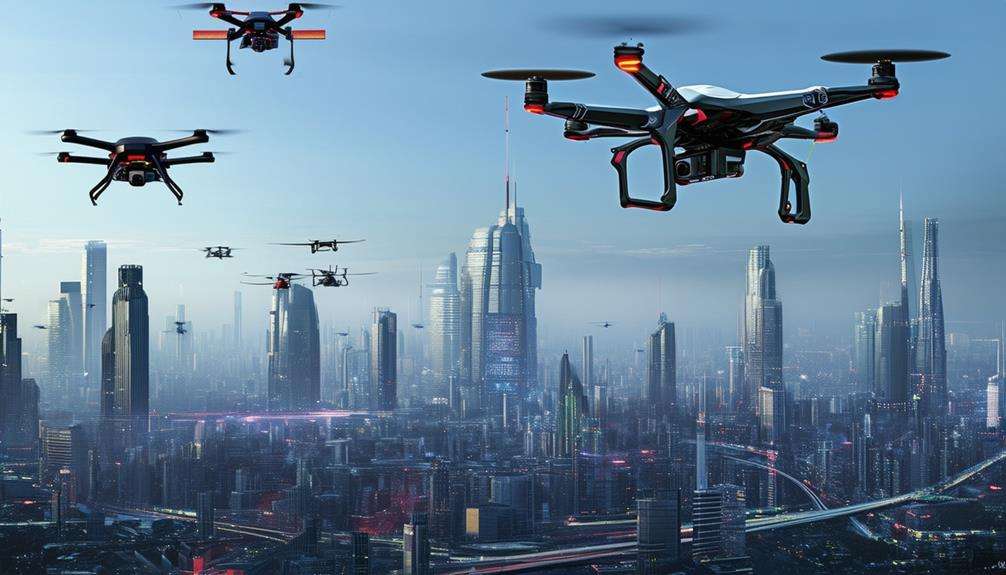
Counter-drone programming has become essential for safeguarding airports, stadiums, and public events from unauthorized drone incursions. The rising threat of unauthorized drone activity poses significant risks to critical infrastructure and public safety. With the increase in rogue hobbyists and potential terrorist activities, robust counter-drone measures are crucial.
Law enforcement agencies now have enhanced authority to monitor, deter, and intercept unauthorized drones. Counter-drone programming focuses on equipping systems to detect, track, and neutralize drones that threaten sensitive airspace. Government support has been pivotal in the rapid development of these technologies, directly addressing public safety concerns.
Key aspects of counter-drone programming include:
| Aspect | Description |
|---|---|
| Detection | Identifying unauthorized drones in protected airspace |
| Tracking | Monitoring the flight path and behavior of intruding drones |
| Neutralization | Disabling or capturing unauthorized drones without causing harm |
| Legal Framework | Expanded authority for law enforcement to act against drone threats |
This evolving sector is critical for protecting vital infrastructure and ensuring public safety, making it an important area to watch in 2024.
New Industry Niches
As the commercial drone market evolves, new industry niches are emerging that highlight the versatility and adaptability of drone technology. Companies are expanding their services to cater to a broader array of customers and industries, enhancing market penetration. This shift is creating pioneering opportunities across various sectors, moving beyond traditional applications.
Consider the following innovative uses:
- Thermal Inspections: Drones equipped with thermal imaging are now essential for detecting heat leaks, identifying electrical issues, and even locating missing persons.
- Traffic Management Analysis: Real-time traffic monitoring and analysis are becoming more effective with drones, aiding in congestion relief and improved urban planning.
- Leasing Services to Non-Aviation Sectors: Companies are leasing drone services to industries such as agriculture, construction, and energy, demonstrating the technology's adaptability.
These trends are opening doors for specialized services, showcasing the potential for niche markets to drive growth and innovation in the drone sector. Industry insights suggest that as these new niches develop, they'll shape the future landscape of commercial drones. By staying informed about these trends, you can better understand the market's evolution and identify where the next significant opportunities may lie.
Sustainable Practices
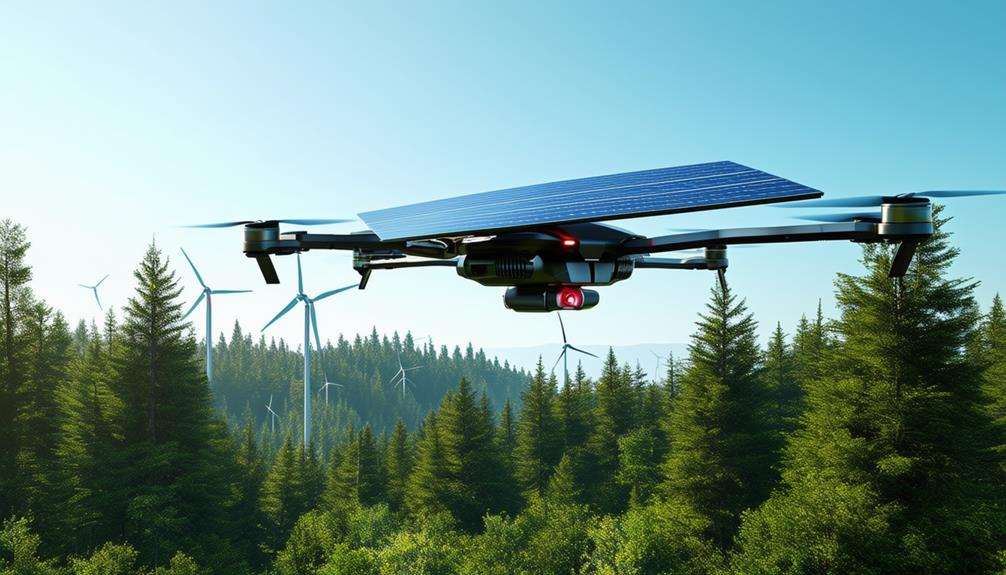
Exploring new industry niches naturally leads us to contemplate how sustainable practices are shaping the future of commercial drone operations. As the industry grows, there's a notable push toward reducing the environmental impact of drones. Companies are increasingly adopting eco-friendly technologies to minimize their carbon footprint.
One of the most promising advancements is the use of solar-powered drones. These drones harness solar energy, reducing reliance on traditional fuels and significantly cutting emissions. Additionally, biofuel solutions are gaining traction as a greener alternative to conventional fuels. By focusing on these energy sources, the industry is making meaningful strides toward sustainability.
Manufacturers are also prioritizing recyclable materials and energy-efficient components in drone construction. This approach not only reduces waste but also ensures that drones are part of a more sustainable lifecycle. These efforts align with global initiatives for environmental conservation and the adoption of green technology.
Enhanced Data Capabilities
Thanks to AI integration, commercial drones now offer advanced data capabilities that significantly improve decision-making and operational efficiency. With artificial intelligence, drones can analyze vast amounts of data in real-time, providing actionable insights for your business. Whether you're in agriculture, construction, or logistics, these AI-driven advancements are transforming your operations.
Imagine the possibilities:
- Predictive Maintenance: AI algorithms analyze performance data to predict when your drone needs servicing, minimizing downtime and extending its lifespan.
- Obstacle Avoidance: AI-powered systems enable drones to navigate complex environments safely, reducing the risk of accidents and ensuring efficient data collection.
- Precision Agriculture: AI-enabled drones monitor crops with pinpoint accuracy, optimizing water usage and fertilization for higher yields and reduced waste.
Incorporating these technologies into your operations ensures precise data collection and better-informed decisions. Autonomous flight capabilities driven by AI allow you to gather data more efficiently and accurately than ever before. By leveraging these advancements, you're not just keeping up with the competition — you're setting new standards for innovation and efficiency in your industry.
Conclusion
In 2024, commercial drones will break new ground across various industries, driven by advancements in AI integration, evolving regulations, and urban air mobility initiatives. These drones will become smarter, safer, and more efficient, unlocking niche markets and specialized services. Emphasizing sustainability and enhanced data capabilities, the industry's growth will be relentless. The future of commercial drones isn't just approaching—it's already here, transforming our world in remarkable ways. Stay informed as this technology continues to reshape multiple sectors.

